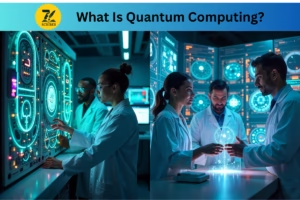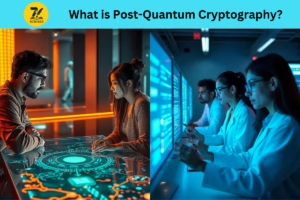What is post-quantum cryptography? Technology has many such fields, but none is as enchanting and promising as quantum cryptography. Yet, even as we dream of its great possibilities, a new menace emerges the threat that it poses to current encryption systems that guard our digital lives. That is where post-quantum cryptography comes into context. But what does that mean? Let us keep it easy.
Understanding quantum computing
To understand post-quantum computing, one should first understand quantum computing. Normal computers process information in 1s and 0s or bits – similar to small switches, which can be toggled on or off. Quantum computers use quantum bits (or qubits) that can exist in multiple states at once (with a little help from superposition). Therefore, it makes them able to process large amounts of information at speeds impossible for classical computers.
Quantum computers also make use of another important principle of quantum mechanics: entanglement. This means that, where such limiting conditions are satisfied, the state of one qubit depends on another’s state, whether or not miles apart. Thus opening the way to solving complex problems – simulation of molecular structures, optimization of logistics – in modes of impossibility with today’s computers.

Problem: A quantum threat to encryption
There is a dire disturbing reality in the exciting modern world of quantum computing- it can wreak havoc in the security systems that we have in place today. All modern-day encryption techniques are based on the premise that large number factorization remains an extremely difficult task for computers. However, quantum computers could break this encryption with ease. Shor’s Algorithm is the quantum algorithm factorizing large numbers exponentially faster than any classical method, which allows quantum computers to easily decrypt sensitive data currently protected by RSA and other similar methods.
This represents a dire threat to everything dependent on encryption; including online banking, private communications, medical records, and so on. Just imagine what would happen if some well-enough quantum computer could decrypt shreds of information that had long been encrypted-the need for a solution is clear.
Enter Post-Quantum Cryptography
Post-quantum cryptography is developing new algorithms and encryption approaches that are quantum secure or resistant. These are basically cryptographic systems that withstand the potential power of quantum computers. Their purpose will be to keep our two data safe even in a world that has many quantum computers.
So what does post-quantum cryptography look like in practice? It really is about designing encryption schemes that rely on problems that quantum computers can solve quickly by factoring in large numbers. However, what researchers are now considering are examining several alternative types of mathematical problems that are believed to be inherently resistant to quantum algorithms.

Post-Quantum Cryptography Key Characteristics
- Grid Cryptography: Lattice-based algorithms are among the most promising post-quantum cryptographic schemes. The basic idea is based on lattices of any dimension or bundle based on the complexity of the lattice mathematics involved. It is believed that lattice-based encryption will be secure against quantum computers.
- The code-based type: This encryption is based on error-correcting codes such as the detection or correction of erroneous data. These types of codes can generate schemes for encryptions that will be hard to break even for quantum computers.
- Hash-Based Cryptography: This kind of cryptography employs cryptographic hash functions; these are mathematical functions with values based on the input and output, always producing fixed-size outputs. These outputs are difficult to reverse and thus provide a good basis for post-quantum encryption.
- Multidimensional Quadratic Equations: This is difficulty regarding solving systems of equations in multitudes of variables. In spite of being tailor-made for certain types of problems, quantum computers still have to solve the system.
- Isogeny-Based Cryptography: In this case, the particular type of study involved is that of elliptic curves and their corresponding transformations or isogenies. It may prove to be an area with much promise for post-quantum applications due to the fact that the mathematical problems involved are particularly hard for quantum computers to solve.
Why post-quantum computers matter
It is not really about post-quantum computing belonging to cryptographers and computer scientists alone, much more to every aspect of our digital lives. As quantum computing advances, it is imperative that industries- from finance to healthcare to government- make strides towards adopting security systems that will be quantum-resilient; since that time will leave critical data vulnerable to attack once quantum computers are brought mainstream.
Other than that, the development in quantum computing has been gradual, and the transition into quantum security evidence will also be gradual. What is really needed now are works with both the current classical systems, as well as into future quantum systems. Such approaches of hybridization ensure that even should quantum computers not have made their widespread time, at least the infrastructure is set up for the day they will.
The Race for Quantum Secure Standards
There is a present race for global common standards towards the post-quantum cryptosystem. The United States National Institute of Standards and Technology (NIST) spearheaded the initiative to post-quantum cryptography standards development. NIST has already narrowed down its list of potential candidates and is now selecting the safest, most practical methods for widespread adoption.
These new standards will contribute to helping companies, governments, and other kinds of organizations secure their systems against future quantum threats. However, the process is still in its infancy; therefore, it going to take years or even decades before a complete transition to quantum-resistant algorithms can be attained.
FAQs
- Will post-quantum cryptography do away with traditional encryption?
Not completely. Post-quantum cryptography is merely an add-on that will supplement traditional methods of encryption, not replace them altogether. We will likely see some combination of traditional and quantum secure methods shortly.
- Can quantum computers break every encryption scheme?
Cryogenic computers are engineered to destroy encryption like RSA and ECC (Elliptic Curve Cryptography); however, many modern encryption methods, especially those based on lattices or other quantum-resistant techniques, are resilient to attacks using quantum capabilities.
- When can we expect Quantum Computers to commence breaking the encryptions we have today?
There is a long way to go before quantum computers become large enough and powerful enough to break today’s encryption. Experts are actually estimating that it will require several decades for such quantum computers to be fully developed, which would give us the time necessary to implement post-quantum solutions.
Read more
The Importance of Lifelong Learning in a Rapidly Changing World
History of Computer :: From Super to Micro (Part-3)
Dominating the SDLC: Unleashing Success